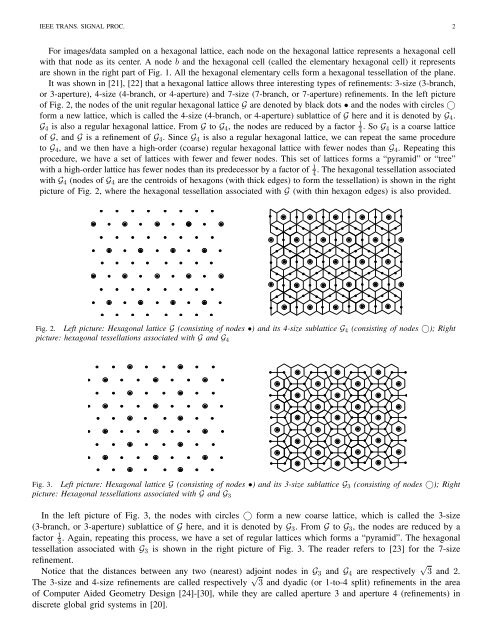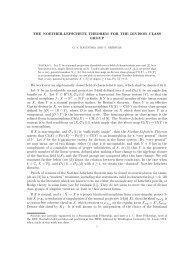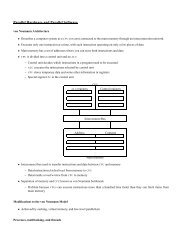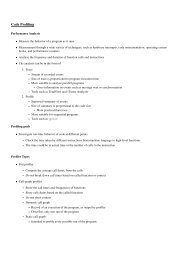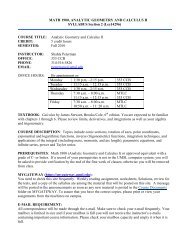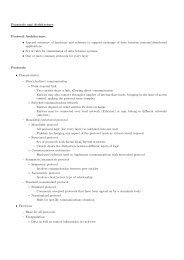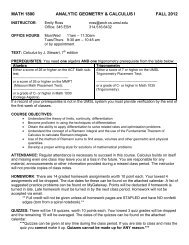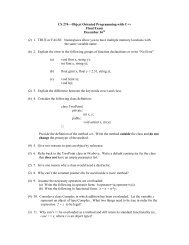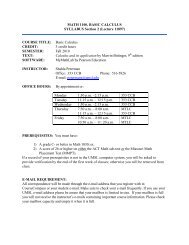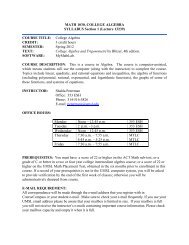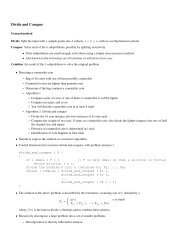here - UMSL : Mathematics and Computer Science - University of ...
here - UMSL : Mathematics and Computer Science - University of ...
here - UMSL : Mathematics and Computer Science - University of ...
Create successful ePaper yourself
Turn your PDF publications into a flip-book with our unique Google optimized e-Paper software.
IEEE TRANS. SIGNAL PROC. 2<br />
For images/data sampled on a hexagonal lattice, each node on the hexagonal lattice represents a hexagonal cell<br />
with that node as its center. A node b <strong>and</strong> the hexagonal cell (called the elementary hexagonal cell) it represents<br />
are shown in the right part <strong>of</strong> Fig. 1. All the hexagonal elementary cells form a hexagonal tessellation <strong>of</strong> the plane.<br />
It was shown in [21], [22] that a hexagonal lattice allows three interesting types <strong>of</strong> refinements: 3-size (3-branch,<br />
or 3-aperture), 4-size (4-branch, or 4-aperture) <strong>and</strong> 7-size (7-branch, or 7-aperture) refinements. In the left picture<br />
<strong>of</strong> Fig. 2, the nodes <strong>of</strong> the unit regular hexagonal lattice G are denoted by black dots • <strong>and</strong> the nodes with circles ○<br />
form a new lattice, which is called the 4-size (4-branch, or 4-aperture) sublattice <strong>of</strong> G <strong>here</strong> <strong>and</strong> it is denoted by G 4 .<br />
G 4 is also a regular hexagonal lattice. From G to G 4 , the nodes are reduced by a factor 1 4 . So G 4 is a coarse lattice<br />
<strong>of</strong> G, <strong>and</strong> G is a refinement <strong>of</strong> G 4 . Since G 4 is also a regular hexagonal lattice, we can repeat the same procedure<br />
to G 4 , <strong>and</strong> we then have a high-order (coarse) regular hexagonal lattice with fewer nodes than G 4 . Repeating this<br />
procedure, we have a set <strong>of</strong> lattices with fewer <strong>and</strong> fewer nodes. This set <strong>of</strong> lattices forms a “pyramid” or “tree”<br />
with a high-order lattice has fewer nodes than its predecessor by a factor <strong>of</strong> 1 4<br />
. The hexagonal tessellation associated<br />
with G 4 (nodes <strong>of</strong> G 4 are the centroids <strong>of</strong> hexagons (with thick edges) to form the tessellation) is shown in the right<br />
picture <strong>of</strong> Fig. 2, w<strong>here</strong> the hexagonal tessellation associated with G (with thin hexagon edges) is also provided.<br />
Fig. 2. Left picture: Hexagonal lattice G (consisting <strong>of</strong> nodes •) <strong>and</strong> its 4-size sublattice G 4 (consisting <strong>of</strong> nodes ○); Right<br />
picture: hexagonal tessellations associated with G <strong>and</strong> G 4<br />
Fig. 3. Left picture: Hexagonal lattice G (consisting <strong>of</strong> nodes •) <strong>and</strong> its 3-size sublattice G 3 (consisting <strong>of</strong> nodes ○); Right<br />
picture: Hexagonal tessellations associated with G <strong>and</strong> G 3<br />
In the left picture <strong>of</strong> Fig. 3, the nodes with circles ○ form a new coarse lattice, which is called the 3-size<br />
(3-branch, or 3-aperture) sublattice <strong>of</strong> G <strong>here</strong>, <strong>and</strong> it is denoted by G 3 . From G to G 3 , the nodes are reduced by a<br />
factor 1 3<br />
. Again, repeating this process, we have a set <strong>of</strong> regular lattices which forms a “pyramid”. The hexagonal<br />
tessellation associated with G 3 is shown in the right picture <strong>of</strong> Fig. 3. The reader refers to [23] for the 7-size<br />
refinement.<br />
Notice that the distances between any two (nearest) adjoint nodes in G 3 <strong>and</strong> G 4 are respectively √ 3 <strong>and</strong> 2.<br />
The 3-size <strong>and</strong> 4-size refinements are called respectively √ 3 <strong>and</strong> dyadic (or 1-to-4 split) refinements in the area<br />
<strong>of</strong> <strong>Computer</strong> Aided Geometry Design [24]-[30], while they are called aperture 3 <strong>and</strong> aperture 4 (refinements) in<br />
discrete global grid systems in [20].


